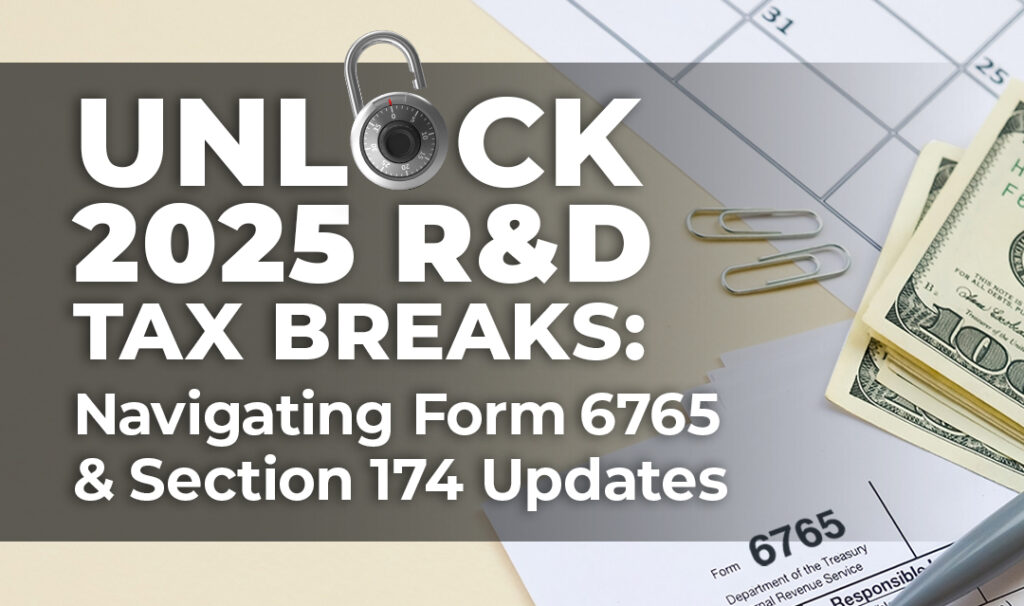How Legislative Changes Have Impacted R&D Tax Credits in 2025
As we look ahead to 2025, businesses claiming the Research & Development (R&D) tax credit should be prepared for key legislative changes that will significantly impact their reporting requirements. These changes are aimed at enhancing tax reporting consistency and improving the quality of information for tax administration. However, they also introduce additional complexity, particularly for businesses with significant R&D investments. In this article, we break down the essential updates and their implications for businesses in 2025.
New Form 6765 Requirements for 2024 and Beyond
In June 2024, the IRS released a revised draft of Form 6765, “Credit for Increasing Research Activities,” used to claim the R&D tax credit. These revisions introduce new requirements that will affect how taxpayers report their Qualified Research Expenses (QREs), starting with the 2024 tax year. Notably, the changes are designed to improve the accuracy and transparency of tax filings but will require more detailed documentation from businesses. Key changes include:
- New Section G: Business Component Detail
- Optional in 2024: Section G is optional for all taxpayers in the 2024 tax year, giving businesses some flexibility.
- Mandatory in 2025: Starting in 2025, Section G becomes mandatory for most taxpayers. However, there are some exceptions for “qualified small business” taxpayers. This exception applies to businesses with total QREs of $1.5 million or less and gross receipts of $50 million or less.
Section G Reporting Requirements:
Taxpayers will need to report 80% of their total QREs, in descending order by amount per business component, up to a maximum of 50 business components. (A business component is the IRS term used to describe a taxpayer’s R&D project.) Each business component will need to include the following qualitative information:
- Business Component Name
- Business Component Type
- Information Sought to Be Discovered
These reporting requirements are designed to provide more transparency into the specific research activities driving the claim for the R&D tax credit. However, the level of detail required in Section G will increase the documentation burden for many businesses.
- New Section E: Other Information
Section E introduces additional requirements that were not part of previous tax filings. These new details include:
- The number of business components generating claimed QREs
- The amount of officers’ wages included in QREs
- Information regarding major business acquisitions or dispositions.
- New categories of expenditures included as QREs
These changes are intended to provide the IRS with a clearer picture of a taxpayer’s R&D activities, further enhancing the accuracy and completeness of R&D tax filings.
- Reordering and Clarification of Existing Fields
In addition to the new sections, the IRS has reordered existing fields on the form and clarified definitions related to officers, controlled group reporting, and business component descriptions. These changes aim to reduce inconsistencies in tax reporting and ensure that businesses are following the most up-to-date guidelines when claiming the R&D tax credit.
Section 174 Amortization Rules: Continuing Impact
While Form 6765 updates are one aspect of recent changes to R&D tax credits, another significant factor affecting businesses is the continuation of Section 174’s amortization requirement. This requirement, which was part of the Tax Cuts and Jobs Act of 2017, remains in effect as of December 2024, and its repeal is still uncertain.
The Section 174 Amortization Requirement
Under Section 174, businesses are required to capitalize and amortize their research and experimental (R&E) expenditures over five years for domestic research and 15 years for foreign research. This change, which took effect on January 1, 2022, has been met with considerable opposition from businesses, especially those with substantial R&D expenditures. The law impacts companies’ ability to fully deduct R&D expenses in the year they are incurred, forcing them to spread out deductions over a longer period.
Legislative Efforts to Reverse Section 174
Several bills have been introduced in an attempt to repeal or modify the Section 174 amortization requirement. Notably:
- H.R. 7024: The Tax Relief for American Families and Workers Act of 2024, passed in the House of Representatives with broad support (357-70). This bill sought to restore businesses’ ability to fully deduct R&D expenses in the year they were incurred, applying retroactively to the 2022 tax year.
- Despite its passage in the House, the bill faced opposition in the Senate. The opposition stemmed primarily from disagreements over other provisions, such as the expansion of Child Tax Credits and election-year politics, which hindered the bill’s progression.
The Future of Section 174
The future of Section 174’s amortization requirement is uncertain. While the prospects of a repeal have increased based on the outcome of the November 2024 presidential and Congressional elections, businesses should not assume immediate changes will occur. If a repeal does happen, it remains uncertain whether it will be retroactive or apply only to future tax years.
Conclusion: What Businesses Should Do Now
While legislative efforts to repeal Section 174’s amortization requirement are ongoing, businesses claiming the R&D tax credit should continue to operate under the current tax laws. This includes adapting to the revised Form 6765 and meeting the more detailed documentation requirements starting with tax year 2024.

Given the complexity of these changes, businesses are encouraged to review their R&D tax credit claims thoroughly and consult with tax professionals to ensure compliance. Firestone Tax Solutions is here to guide you through these evolving tax requirements and help your business maximize its tax benefits, even in the face of legislative uncertainty.
By staying informed and proactive, businesses can navigate these changes and continue to leverage R&D tax credits as a key strategy for growth and innovation.
For further guidance on how these changes impact your business, please contact us at Firestone Tax Solutions. We’re here to help you maximize your R&D tax credits and minimize your tax burden.

